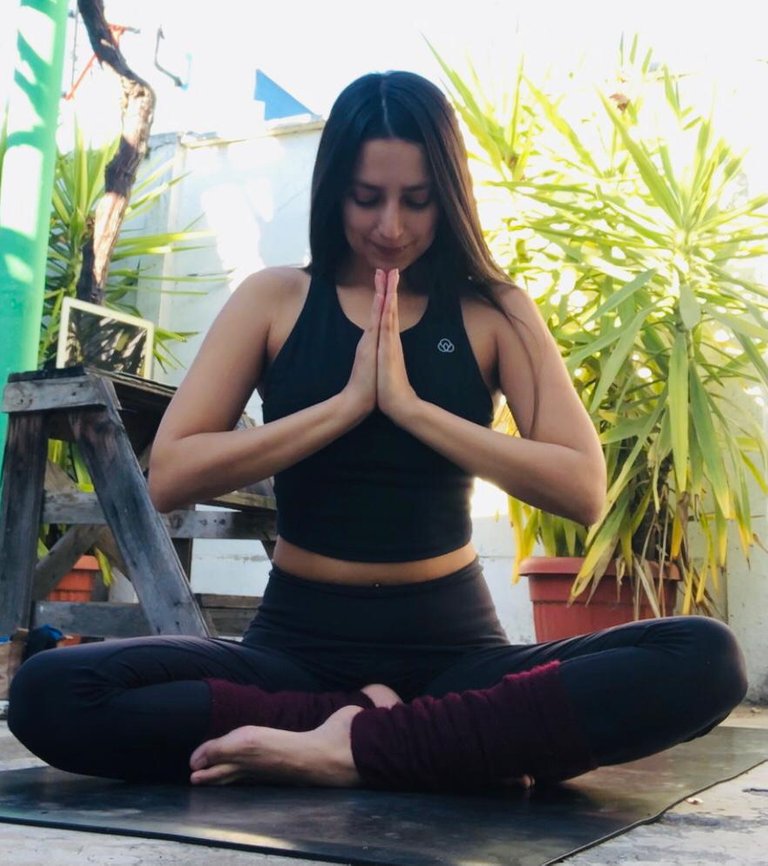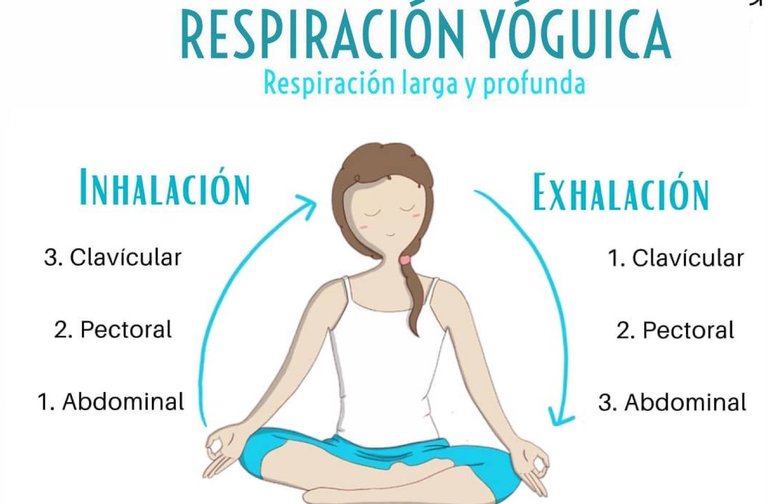Yogic breathing or complete breathing, is a more common pranayama technique in a yoga session, it is a breathing exercise that works through the 3 types of breathing (Abdominal, thoracic and clavicular), which allows us to use all of our lung capacity helping us to obtain maximum oxygenation in a single inhalation, it is very beneficial in moments of fatigue, tension or mental dispersion and helps us maintain self-control.
.
Pranayama is composed of 2 words, prana which is our vital energy or breath, while yama translates as regulation, control or domination, concluding that pranayama is the art that teaches sets of techniques to control breath and energy.La respiración yóguica o respiración completa, es una técnica de pranayama más comunes en una sesión de yoga, trata de un ejercicio de respiración que funciona a través de los 3 tipos de respiración (Abdominal, torácica y clavicular), que nos permite utilizar toda nuestra capacidad pulmonar ayudándonos a obtener la máxima oxigenación en una sola inhalación, es muy beneficiosa en momentos de cansancios, tensión, o dispersión mental y nos ayuda a mantener el autocontrol.
Pranayama se compone por 2 palabras, prana que es nuestra energía vital o respiración, mientras que yama se traduce como regulación, control o dominio, concluyendo que pranayama es el arte que enseña conjuntos de técnicas para controlar la respiración y la energía.

As I explained at the beginning, yogic breathing combines 3 types of breathing;
Abdominal (deep): This breath uses the diaphragm (it is the muscle below the ribs and above the stomach), causing the stomach to rise and fall instead of the chest.
Thoracic (Middle): Performed with the rib muscles, it expands the rib cage, filling the lungs with air.
Clavicular (short): It is done with the upper part of the lungs, little air is taken in, when inhaling the clavicles rise slightly.
Como expuse al inicio, la respiración yóguica combina 3 tipos de respiración;
Abdominal (Profunda): Esta respiración usa el diafragma (es el músculo que se encuentra debajo de las costillas y arriba del estómago), provocando que el estómago suba y baje en vez del pecho.
Torácica (Media): Se realiza con los músculos de las costillas, expande la caja torácica, llenando de aire los pulmones.
Clavicular (corta):Se realiza con la parte alta de los pulmones, se coge poco aire, al inhalar se elevan ligeramente las clavículas.

During the execution of this exercise, the process is as follows: When you inhale:
It is performed in 3 stages, following the abdomen - thorax - clavicle sequence.
When you exhale; the same pattern is fulfilled but in reverse, clavicle - thorax - abdomen.
.
How to do it?
- Adopt a comfortable posture, you can be lying down or sitting.
- Breathing is done only through the nose.
- The right hand on the abdomen without forcing, and the left hand on the chest, (if lying down, the elbows touch the ground). So you can feel when the air enters and leaves your body.
- Take three deep breaths before you begin.
- Inhale first filling the abdomen with air, you will feel how little by little it expands naturally.
- Keep inhaling deeply and feel your chest area expand and fill with air.
- When your chest is full, inhale a little more lifting your collarbone and chest.
- Hold the air for a few seconds without tension (relaxing shoulders and face), then proceed with the exhalation process little by little in the same 3 times in reverse.
- Release the air from your lungs starting from the top (collarbone) slowly, then the rib cage, and finally the abdominal area.
- Let your lungs remain empty for a few moments before restarting the practice.
.
It is recommended to do it every day for 3 minutes. It can be done at any time of the day, to calm us down and be in balance.Learning this breath and applying it consciously in a slow and deep way, our life expands, increasing our health, we will be happier and we will live with more tranquility.
"It's time to put it into practice, your body and mind will thank you"
Durante la ejecución de este ejercicio, el proceso es el siguiente:
Cuando inhalas.
Se realiza en 3 tiempos, siguiendo la secuencia abdomen - tórax - clavícula.
Cuando exhalas; se cumple el mismo patrón pero a la inversa, clavícula - tórax - abdomen.
- Toma una postura cómoda, puede ser tumbado o sentado.
- La respiración se realiza únicamente por la nariz.
- La mano derecha sobre el abdomen sin forzar, y la mano izquierda sobre el pecho, (si estás tumbado los codos tocan el suelo). Así podrás sentir cuando el aire entra y sale de tu cuerpo.
- Haz tres respiraciones profundas antes de empezar.
- Inhala primero llenando de aire el abdomen, sentirás como poco a poco se expande de forma natural.
- Sigue inhalando profundamente y siente como la zona del tórax se expande y se va llenando de aire.
- Cuando el tórax esté lleno, inspira un poco más elevando la clavícula y el pecho.
- Retén el aire unos segundos sin tensión (relajando hombros y el rostro), luego procede el proceso de exhalación poco a poco en los mismo 3 tiempos a la inversa.
- Libera el aire de tus pulmones iniciando desde la parte superior (clavícula) lentamente, luego la caja torácica y finalmente la zona abdominal.
- Deja que los pulmones permanezcan vacíos unos instantes, antes de reiniciar la práctica.
Es recomendable realizarla todos los días durante 3 minutos. Se puede realizar en cualquier momento del día, para calmarnos y estar en equilibrio.
Aprendiendo esta respiración y aplicándola conscientemente de modo lenta y profunda, nuestra vida se expande, incrementando nuestra salud, seremos más felices, y viviremos más tranquilos.
“Es momento de ponerlo en practica, tu cuerpo y mente te lo agradecerán”
Una buena explicación de lo que es una respiración yoguica, es igual a la de meditación libre, respirar ayuda mucho a la mente y al cuerpo. Hiciste un buen trabajo con este tema, gracias por compartirlo. :D
Come say hi via Lotus Chat or drop by our community - we'd love to welcome you!
Muchas gracias! Es increible como esto nos ayuda tanto a nivel físico como mental.
Excelente! Eres como yo, del "equipo respiración". Es una herramienta muy poderosa en muchos sentidos y es importante aprender todo lo que podamos sobre ella! Me gustó mucho tu publicación, y considero que podemos postularla para el próximo post de curacion de Lotus for Yogis.
P.D: Fijate de que cuando coloques una foto que no sea de tu autoría, colocar al pie de la foto la fuente de donde encontraste dicha imagen.
Por ejemplo:
Fuente/Sourse
Hay muchos curadores importantes en la plataforma que se fijan en que las imagenes así, estén bien referenciadas, así que seguro te va a ayudar a sumar más recompensas a tus post.
Exitos. Un abrazo!
Earn Instantly For Writing Natural Health Content
Earn LOTUS and HIVE rewards for sharing your natural health content on www.naturalmedicine.io. If you don't already have a HIVE account, you can sign up for
FREEhere. We support writers sharing about herbalism, TCM, yoga, meditation, vegan and other healthy diets, as well as earth centred practices such as foraging, permaculture and biodynamics - read more about us on our Welcome Page!Muchas gracias por leer, Es una herramienta poderosa !!
Y gracias por el tips sobre la fuente de la imagen!
Saludos 😀
Congratulations @katherinevc! You have completed the following achievement on the Hive blockchain and have been rewarded with new badge(s) :
Your next target is to reach 1250 upvotes.
You can view your badges on your board and compare yourself to others in the Ranking
If you no longer want to receive notifications, reply to this comment with the word
STOPCheck out the last post from @hivebuzz:
Support the HiveBuzz project. Vote for our proposal!
This post took me back to the memories of my time in India, where pranayama was practiced every day. very nostalgic reading this has your precise instructions and explanation of pranayama reminds me the Indian teachings.
thanks for sharing, clear and sharp very easy to follow :)
much love
Thanks so much for reading. And nice that it reminds you of incredible moments.
a hug❤️